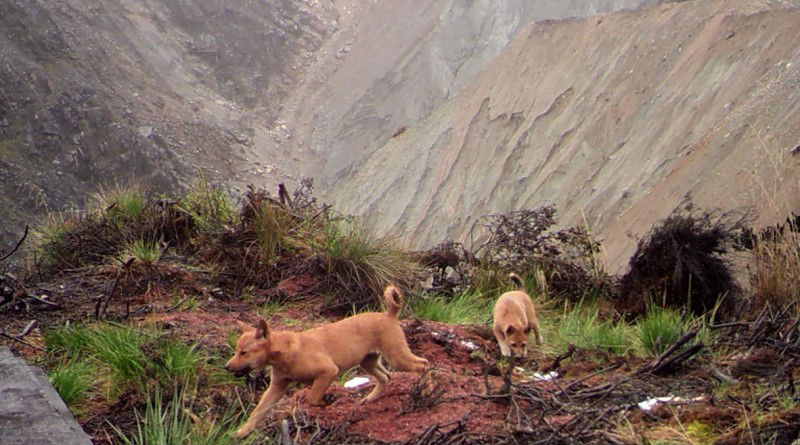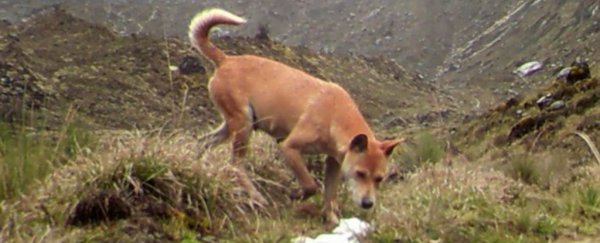After decades of fearing that the New Guinea highland wild dog had gone extinct in its native habitat, researchers have finally confirmed the existence of a healthy, viable population, hidden in one of the most remote and inhospitable regions on Earth.
According to DNA analysis, these are the most ancient and primitive canids in existence, and a recent expedition to New Guinea's remote central mountain spine has resulted in more than 100 photographs of at least 15 wild individuals, including males, females, and pups, thriving in isolation and far from human contact.
"The discovery and confirmation of the highland wild dog for the first time in over half a century is not only exciting, but an incredible opportunity for science," says the group behind the discovery, the New Guinea Highland Wild Dog Foundation (NGHWDF).
"The 2016 Expedition was able to locate, observe, gather documentation and biological samples, and confirm through DNA testing that at least some specimens still exist and thrive in the highlands of New Guinea."
If you're not familiar with these handsome creatures, until now, New Guinea highland wild dogs were only known from two promising but unconfirmed photographs in recent years - one taken in 2005, and the other in 2012.
They had not been documented with certainty in their native range in over half a century, and experts feared that what was left of the ancient dogs had dwindled to extinction.
But maybe they were just really good at hiding?
Last year, a NGHWDF expedition made it to the Papua province of western New Guinea, which is bordered by Papua New Guinea to the east and the West Papua province to the west.
Led by zoologist James K McIntyre, the expedition ran into local researchers from the University of Papua, who were also on the trail of the elusive dogs.
A muddy paw print in September 2016 finally gave them what they were looking for - recent signs that something distinctly dog-like was wandering the dense forests of the New Guinea highlands, some 3,460 to 4,400 metres (11,351 to 14,435 feet) above sea level.
Trail cameras were immediately deployed throughout the area, so they could monitor bait sites around the clock. The cameras captured more than 140 images of wild Highland Wild Dog in just two days on Puncak Jaya - the highest summit of Mount Carstensz, and the tallest island peak in the world.
 Pregnant female. Credit: NGHWDF
Pregnant female. Credit: NGHWDF
 Highland wild dog pups. Credit: NGHWDF
Highland wild dog pups. Credit: NGHWDF
The team was also able to observe and document dogs in the area first-hand, and DNA analysis of faecal samples have confirmed their relationship to Australian dingos and New Guinea singing dogs - the captive-bred variants of the New Guinea highland wild dog.
Due to the lack of evidence of the species, it's been unclear exactly how dingoes, singing dogs, and highland wild dogs actually relate to one another, but that's a question that will hopefully soon be answered, because these animals truly are our best bet for getting a better understanding of canid evolution.
"The fossil record indicates the species established itself on the island at least 6,000 years ago, believed to have arrived with human migrants. However, new evidence suggests they may have migrated independently of humans.
While the taxonomy and phylogenetic relationships with related breeds and Australian dingoes is currently controversial and under review for both New Guinea singing dogs and highland wild dogs, the scientific and historical importance of the highland wild dog remains critical to understanding canid evolution, canid and human co-evolution and migrations, and human ecology and settlement derived from the study of canids and canid evolution."
As far as dogs go, you'd be hard-pressed to find a more attractive one - their coats are most commonly golden, but there are also black and tan, and cream variants. Their tails are carried high over their backsides in a fish hook shape, like a Shiba Inu.
In all of the dogs observed so far, their ears sit erect and triangular on the top of the head.
 Some of the wild dog sightings. Credit: NGHWDF
Some of the wild dog sightings. Credit: NGHWDF
 A wary observer. Credit: NGHWDF
A wary observer. Credit: NGHWDF
Though it's yet to be confirmed, the highland wild dogs could make the same unique vocalisations of their captive-bred counterparts - the New Guinea singing dogs.
According to the NGHWDF, there are roughly 300 New Guinea singing dogs remaining in the world, living in zoos, private facilities, and private homes, and they're known for their high-pitched howls, which they will perform in chorus with one another, and sometimes for several minutes at a time:
The research into these amazing dogs is ongoing, and a scientific paper on the discovery is expected to be released in the coming months.
And the good news is the researchers are optimistic of the highland wild dogs' chances of survival.
Local mining companies have been tasked with taking special environmental stewardship measures to protect the remote area and ecosystem surrounding their facilities, which means they have "inadvertently created a sanctuary in which the HWD could thrive", says the NGHWDF.
You can read more about the expedition and discovery here.
